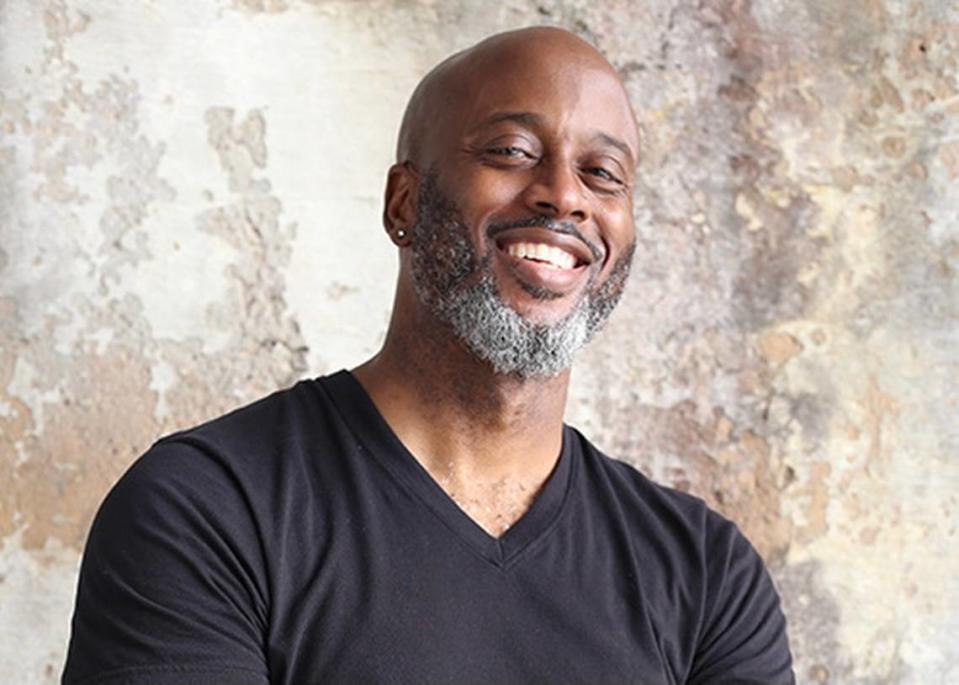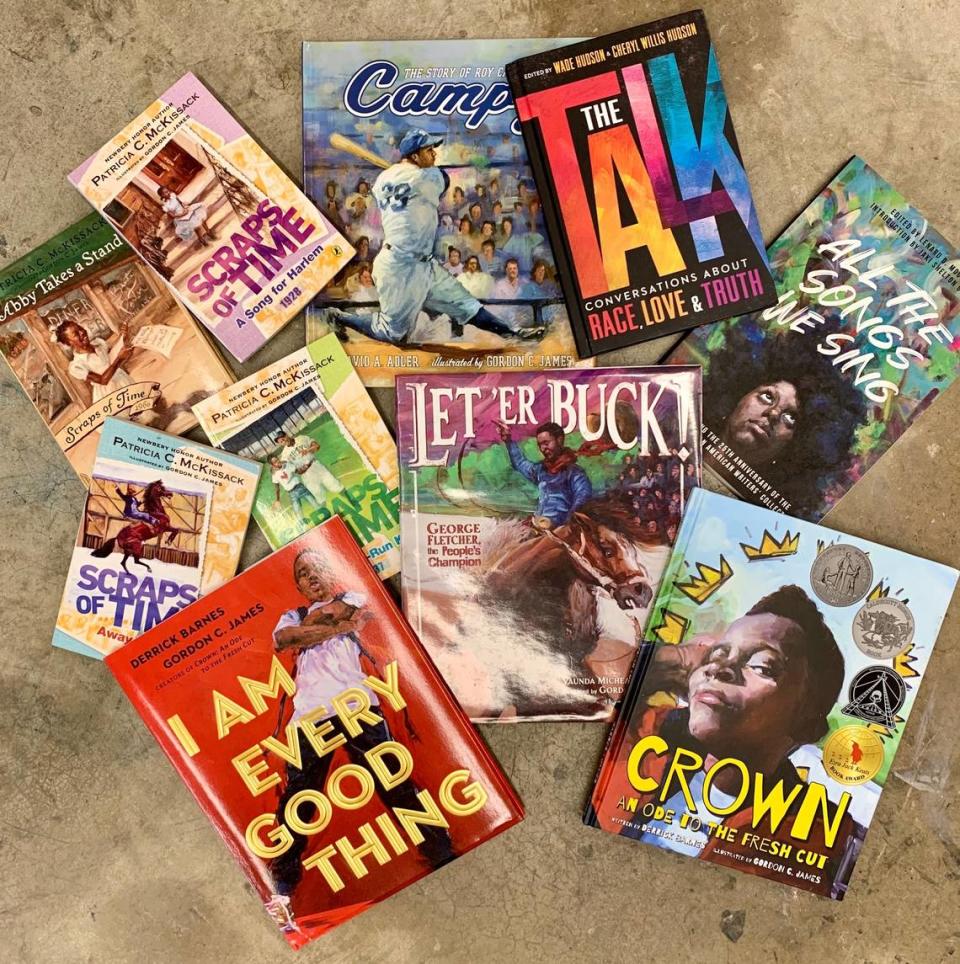A Black NC painter finds success illustrating kids’ books with people who look like him
The Charlotte area’s most decorated children’s book illustrator never intended to go down that career path.
Gordon C. James, a trained fine artist who has a studio at ClearWater Arts Center & Studios in Concord, has built a decades-long career creating oil paintings that play with light and depths of shadow to reveal more of a subject than meets the eye.
His work has been featured in galleries and exhibits, including at the Mint Museum. However, it was his “side hustle” that, along with author Derrick Barnes, garnered the Kirkus Prize for Young Readers’ Literature for their book “I am Every Good Thing” in 2020. The publisher, Nancy Paulsen Books, an imprint of Penguin Random House, described it as an upbeat, empowering picture book with a confident Black narrator.
James and Barnes are the first to win the Kirkus award twice. Their “Crown: An Ode to the Fresh Cut” won the award in 2018. That book was in the form of a poem about describing a boy’s feelings while getting a haircut.
“It’s very surreal. I never thought I’d be a full-time illustrator,” James said.
But he had to reconsider once the awards began rolling in. In addition to the Kirkus Prize, “Every Good Thing” spent six weeks on the New York Times bestseller list and took him to the ”Drew Barrymore Show.”
Meanwhile, “Crown” is featured in an episode of the ”Bookmarks” series on Netflix.
It won a Caldecott honor, a Coretta Scott King Book Award, a John Newbery medal and garnered the duo the Ezra Jack Keats Award, given annually to an outstanding new writer and new illustrator. “Crown” is one of the most decorated children’s books in modern times.
“It lets you know that these children’s books are important,” James said. “They speak to a lot of people and help kids with pride and confidence. It lets them learn about people they wouldn’t and recognize themselves. It’s important.”

Critical acclaim aside, James has found that illustrating has actually improved his painting skills.
“Every time I pick up the brush to do a book, I’m becoming a better painter. And children respond to the artwork,” he said. “I don’t have to dumb it down for them. They can pick it up. They know what you’re doing.”
Art in his blood
James comes from a family of artists, though most ultimately chose more pragmatic professions.
His father, a Washington, D.C., police officer, attended as a singer Fiorello H. LaGuardia High School of Music & Art and Performing Arts of “Fame” renown. His cousin worked as an artist at DC Comics before becoming a math teacher.
“The previous generation of my family on both sides were all creative people who took the safer bet. But my parents were generally supportive,” James said. “I felt like I had the luxury to go out and attempt big things and to fail. It’s not a luxury a lot of people give their children.”
Both his father and his mother, a teacher, were the children of West Indian immigrants.
They didn’t have much money when James was growing up, so they were determined to see their son direct his own course in the world. Knowing James’ artistic ambitions, his father took him to museums and art exhibits on weekends, and the family proudly displayed his projects and awards in their home.
“My father told me he did what he had to do so I could do what I wanted to do. Any problems I had were first-world problems. I’m lucky I didn’t have to start from scratch,” he said.
After earning a fine arts degree, James began his career as an oil painter. True to his pragmatic roots, he also took a day job at Hallmark designing greeting cards. He had done some illustrating sporadically, but that kind of work was few and far between when he was approached with an opportunity.
Barnes, who was on the writing staff at Hallmark, had just finished an incredible children’s story.
But “Crown” was self-financed, and Barnes had a hard time finding an illustrator willing to take on the project with its limited budget. At the time, James’ wife had just gotten downsized from her marketing executive job, and he was looking for more income streams.

“I had taken a teaching gig and was putting out freelance feelers, but I hadn’t done a children’s book in eight years. People wanted a flatter, sweeter style,” James said. “But I told my wife I would take this job and crush it.
“I planned to put way more time into it than I was being paid for in order to make it the best portfolio piece I could and get more work... It’s worked better than I could have imagined.”
Now, James’ issue may be too much work.
He illustrated “Just Like Jesse,” a book about Andrew Young, who was inspired by Jesse Owens, for Scholastic. He’s also working on a book about Thurgood Marshall and partnered with Barnes on a short story for the anthology, “The Talk,” which looks at race from different perspectives and is due to be released April 13.
Philosophy
“Crown” is rare in publishing: It’s a book with a Black author, a Black illustrator, a Black literary agent and a Black publisher. “Every Good Thing” is almost as rooted, except the publisher, Nancy Paulson, is white.
“I don’t believe you have to be Black to tell our stories because if someone asks me to do a book about George Washington, I’ll do it. But there weren’t a lot of books with characters who looked like me. I love being able to add that balance,” he said.
James feels it is important for children to see themselves in books, and particularly for Black children to be aware of their history but also of future possibilities.
That’s why he creates characters that are drawn from history, as well as those who are everyday kids full of self-esteem and joy.
He sees it as part of a mission to give kids tools to deal with adverse encounters in life. Young readers will know they can excel because they’ve seen pictures of people who look like them doing incredible things.
“Our history is important and vital, and we should know it back and forth, but we’re not just our history,” he said. “I don’t want kids to think they’ll always be fighting something.
“I am not defined by what people have tried to do to me. What I like about ‘Every Good Thing’ is that you’re good because you’re good, not because you had to overcome what people tried to do to you. This representation is really important.”
More arts coverage
Want to see more stories like this? You can join our Facebook group, “Inside Charlotte Arts,” at https://www.facebook.com/groups/insidecharlottearts/

